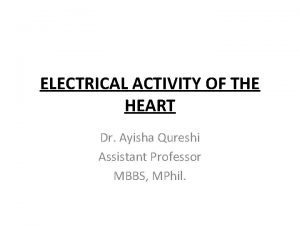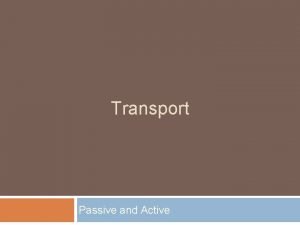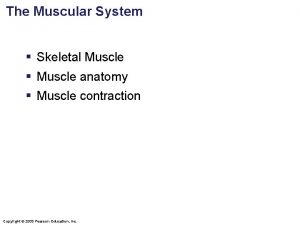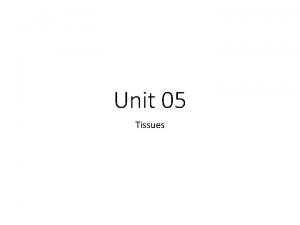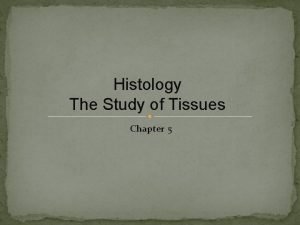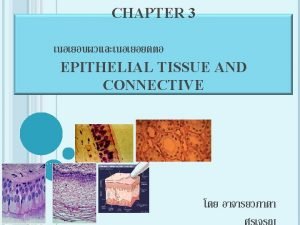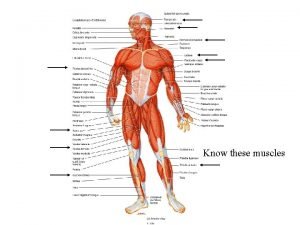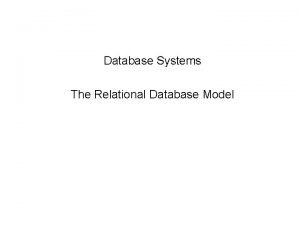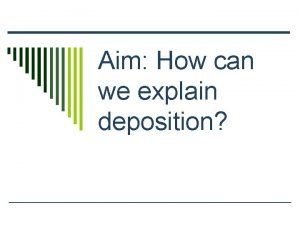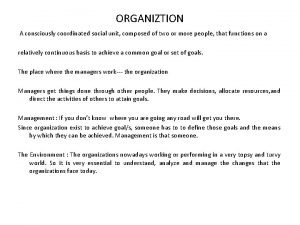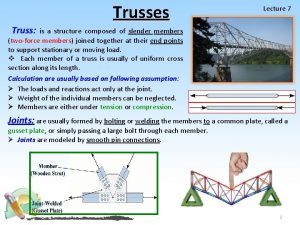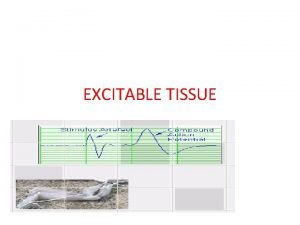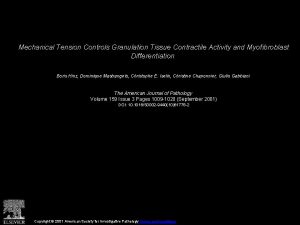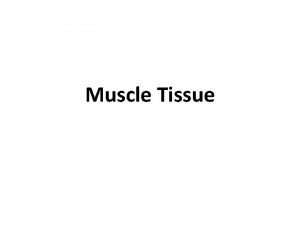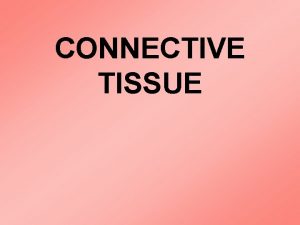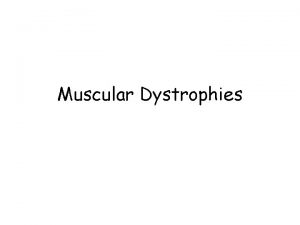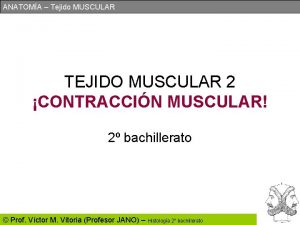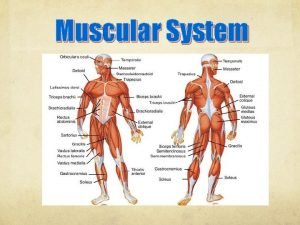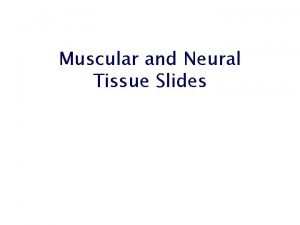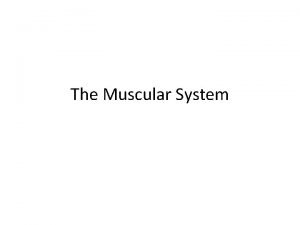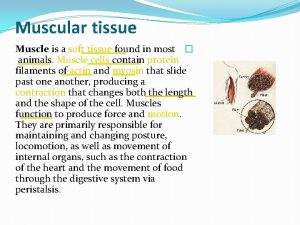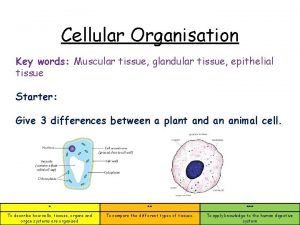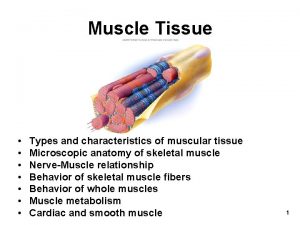Muscular Tissue Muscular contractile tissue is composed of

















- Slides: 17

Muscular Tissue • Muscular (contractile) tissue is composed of cells called muscle fibers. • Muscle fibers contain actin and myosin filaments; interactions result in animal movement. • Three types of vertebrate muscle tissue are: • Skeletal • Cardiac • Smooth

Microscopic Anatomy & Physiology • Myofibrils are contractile portions of fibers that lie parallel and run length of fiber. • Protein filaments: • thick (made of myosin) • thin (made of actin) • Sarcomere has repeating bands of actin and myosin that occur between two Z lines in myofibril. • I band contains only actin filaments. • H zone contains only myosin filaments. • Anatomy of skeletal muscle 2. ram


Sliding Filament Model • As a muscle fiber contracts, sarcomeres within myofibrils shorten. • As sarcomere shortens, actin filaments slide past myosin; I band shortens and H zone disappears. • Sliding filament theory: • actin filaments slide past myosin filaments because myosin filaments have crossbridges that pull actin filaments inward, toward their Z line.

Sliding Filament Model • Contraction process involves sarcomere shortening, filaments themselves remain same length. • ATP supplies energy for muscle contraction. • Myosin filaments break down ATP to form crossbridges that attach to and pull actin filament.

Muscular Contraction • Ca 2+ ions bind to troponin, which causes tropomyosin threads to shift position. • Change in structure of tropomyosin exposes myosin heads with ATP binding sites. • The myosin heads function as ATPase enzymes, splitting ATP into ADP + P • After attaching to actin filaments, myosin cross-bridges bend forward, actin filament is pulled along.


http: //highered. mheducation. com/sites/0072495855/student_view 0/c hapter 10/animation__sarcomere_contraction. html

Fast twitch & slow twitch muscles • Slow twitch muscle fibers • contract slowly, but keep going for a long time • more mitochondria for aerobic respiration • less SR Ca 2+ remains in cytosol longer • long distance runner • “dark” meat = more blood vessels • Fast twitch muscle fibers • contract quickly, but get tired rapidly • store more glycogen for anaerobic respiration • sprinter • “white” meat

Diseases of Muscle tissue • ALS • amyotrophic lateral sclerosis • Lou Gehrig’s disease • motor neurons degenerate • Myasthenia gravis • auto-immune • antibodies to acetylcholine receptors Stephen Hawking

Botox • Bacteria Clostridium botulinum toxin • blocks release of acetylcholine • botulism can be fatal muscle

Rigor mortis no life, no breathing u no breathing, no O 2 u no O 2, no aerobic respiration u no aerobic respiration, no ATP u no ATP, no Ca 2+ pumps u Ca 2+ stays in muscle cytoplasm u muscle fibers continually contract u § tetany or rigor mortis u eventually tissues breakdown & relax § measure of time of death

Signal Transduction Pathway Fig. 49. 2 Copyright © 2002 Pearson Education, Inc. , publishing as Benjamin Cummings

• Sensory reception begins with the detection of stimuli by sensory receptors. • Exteroreceptors detect stimuli originating outside the body. • Interoreceptors detect stimuli originating inside the body. Copyright © 2002 Pearson Education, Inc. , publishing as Benjamin Cummings

Sensory Processing • Transduction. • The conversion of stimulus energy into a change in membrane potential. • Amplification. • The strengthening of stimulus energy that is can be detected by the nervous system. • Transmission. • The conduction of sensory impulses to the CNS. • Integration. • The processing of sensory information. Copyright © 2002 Pearson Education, Inc. , publishing as Benjamin Cummings

Sensory Receptors • Mechanoreceptors respond to mechanical energy. • Pain receptors = nocioceptors. • Different types of pain receptors respond to different types of pain. • Thermoreceptors respond to heat or cold. • Respond to both surface and body core temperature. • Chemoreceptors respond to chemical stimuli. • Electromagnetic receptors respond to electromagnetic energy. • Photoreceptors respond to the radiation we know as visible light. Copyright © 2002 Pearson Education, Inc. , publishing as Benjamin Cummings

• http: //www. mindbites. com/series/423 -biology-the-nerve-impulse
 Chapter 6 the muscular system figure 6-9
Chapter 6 the muscular system figure 6-9 Action potential in contractile cells
Action potential in contractile cells Is contractile vacuole active or passive
Is contractile vacuole active or passive Contractile unit of muscle
Contractile unit of muscle Characteristics of simple squamous epithelium?
Characteristics of simple squamous epithelium? Reticuloendothelial tissue is composed of cells that are
Reticuloendothelial tissue is composed of cells that are Tissue is composed of a group of -
Tissue is composed of a group of - Plyometrics disadvantages
Plyometrics disadvantages Function of muscular tissue
Function of muscular tissue Properties of muscle
Properties of muscle Muscular tissue
Muscular tissue Perforation plates
Perforation plates What does blood consist of
What does blood consist of Two-dimensional structure composed of rows and columns
Two-dimensional structure composed of rows and columns A low hill is composed of unsorted sediments
A low hill is composed of unsorted sediments Consciously coordinated
Consciously coordinated Earth has not anything to show more fair figure of speech
Earth has not anything to show more fair figure of speech Zero force member examples
Zero force member examples

